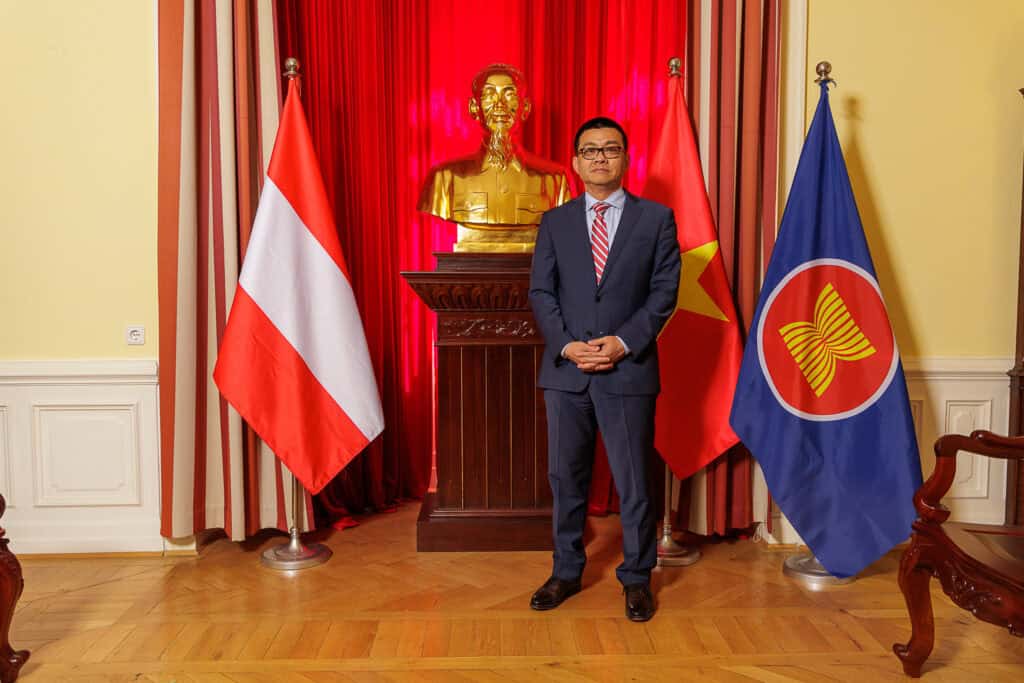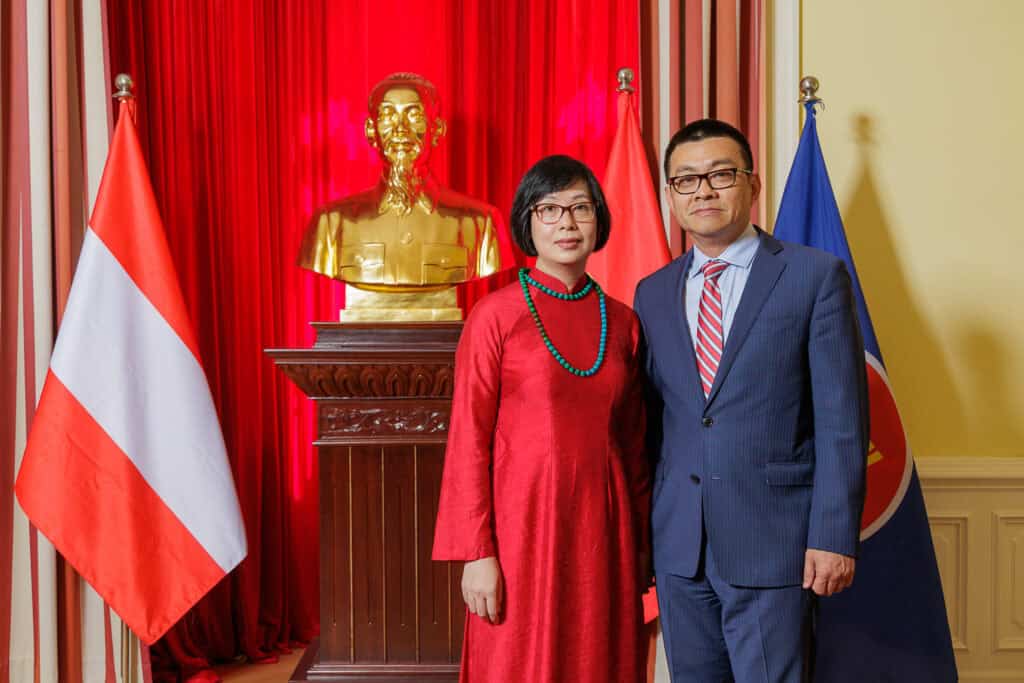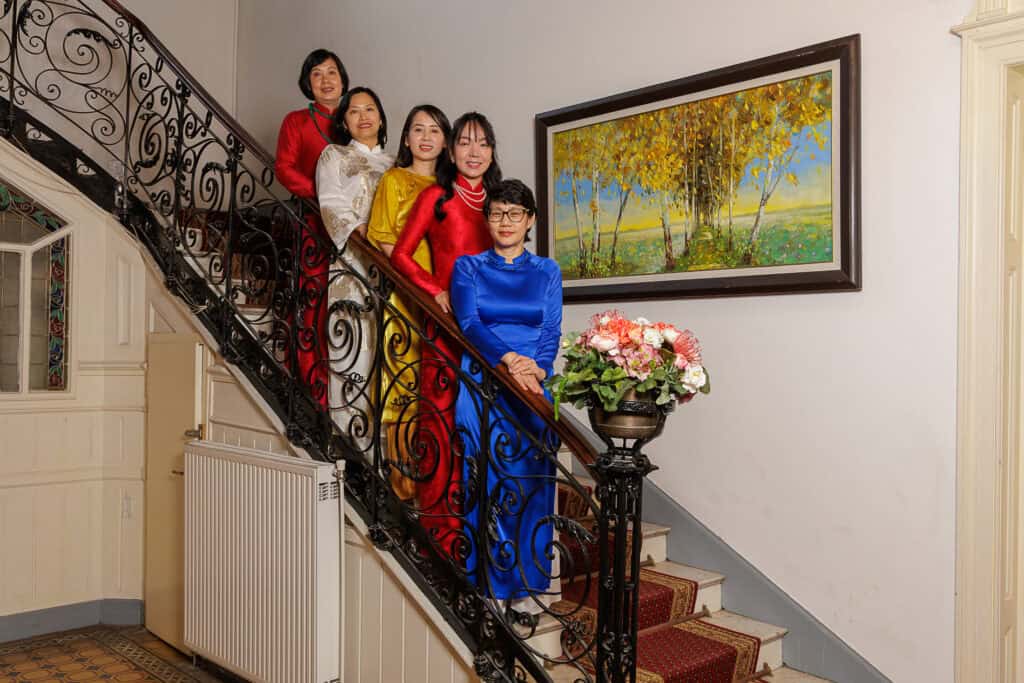Diplomatic SOCIETY sat down with H.E. Le Thai Hoang VU, Ambassador of Viet Nam to Austria, and spoke about the numerous anniversaries the country is celebrating in 2025, the cooperation with Austria, and his personal recommendations for a trip to his home country.
Viet Nam is celebrating 80 years of independence, among many other anniversaries in 2025, what were the milestones of Viet Nam’s history since then?
On September 2, 1945, at Ba Dinh Square in Hanoi, Ho Chi Minh, the President of the Provisional Government of Viet Nam, read the Declaration of Independence. This moment marked the birth of the first workers‘ and peasants‘ state in Southeast Asia. However, this peace did not last long. Soon, the Vietnamese had to begin their struggle for independence, which would last for 30 years until April 30, 1975, when Viet Nam was reunited. For this reason, this year marks the 80th anniversary of the founding of the state and the 50th anniversary of national reunification, to be commemorated with an extensive political and cultural program.
After reunification, the country did not come to rest. The next ten years, from 1976 to 1986, were marked by regional conflicts, embargoes, economic crisis, hyperinflation, and international isolation. It wasn’t until the 6th Party Congress in 1986 that a new course was set for Viet Nam’s policy of renovation. The country gradually returned to the international stage—first, by establishing relations with the European Community (EC) in 1990 and signing the Framework Cooperation Agreement with the European Union (EU), then joining ASEAN in 1995, and most notably, normalizing relations with the US in the same year. In 2007, Viet Nam became the 150th member of the World Trade Organization – the culmination of its reforms and integration process that began in the mid-1990s. As of now, Viet Nam has diplomatic relations with 194 countries, its network of strategic partnership expands to 37 countries, including all major powers and five permanent members of the UN Security Council, and it is a proactive and responsible member of more than 70 global and regional organizations.
Since the 6th Party Congress in 1986, Viet Nam’s economy has developed dynamically. Let me share some impressive figures from the year 2024: GDP growth rate of 7.09%, economic size of 470 billion USD, and an economic freedom index that climbed 13 positions to rank 59 out of 176 countries. Viet Nam is among the top 15 developing countries with the highest foreign direct investment (FDI) globally, with a total of 40 billion USD, of which about 25 billion USD has already been realized. Viet Nam ranks among the top 20 trading nations, with 17 free trade agreements (FTAs). The country is undergoing a dynamic transformation towards a digital, green, and technology-based economy that is environmentally friendly. Particularly in the global semiconductor supply chains, Viet Nam has attained a key position and is attracting numerous major tech companies.
Coming back to the 80 years anniversary, on this auspicious day, we fondly remember a great figure, the founding father of Viet Nam, whom we affectionately call “Uncle Ho” or “Father of the Nation.” President Ho Chi Minh was born 135 years ago in 1890, at a time when the country was colonized by French powers and the name of Viet Nam did not appear anywhere on the world map. The young man Nguyen Ai Quoc (translated: “the Patriot”) believed that the country could only be liberated through modernization, the abolition of feudal rule, and the expulsion of occupying forces. Thus, in 1911, he embarked on a three-decade-long world journey in search of a path to national salvation.
The ideas of the American Declaration of Independence in 1776, that „all men are created equal, that they are endowed by their Creator with certain unalienable Rights, that among these are Life, Liberty, and the pursuit of Happiness,“ and the French Declaration of the Rights of Man and of the Citizen in 1791, stating that „Men are born and remain free and equal in rights,“ inspired the revolutionary leader, by then known as Ho Chi Minh, and were included in the Vietnamese Declaration of Independence in 1945. He continued his work as President until his death in 1969, and the victory in April 1975 was dedicated to him.
Ho Chi Minh is not only a heroic figure in Viet Nam. He served as a role model for independence movements in colonial countries during the 1960s and for international solidarity. The literary legacy of President Ho Chi Minh is diverse. Many of his writings are considered classics of Vietnamese literature. Particularly cherished is his Prison diary, written in Chinese, which has been translated into English and French. In 1987, he was recognized by UNESCO as a national liberation hero and an outstanding cultural figure of Viet Nam.





Viet Nam and Austria signed a financial cooperation agreement on June 23 (in Hanoi), under which Austria is set to fund 150 million Euros for Viet Nam’s crucial socio-economic development projects – can you tell us a bit more about this cooperation?
The agreement came into effect on August 1, 2025, establishing an important framework to support development projects in Viet Nam.
Austria and Viet Nam have long maintained close economic relations. The recently signed agreement, with a total framework amount of 150 million euros, represents a significant contribution to deepening bilateral relations. The focus is on financing public sector initiatives that are crucial to Viet Nam’s national development strategy.
Of this amount, 100 million euros will be made available as tied concessional loans, and for the first time, 50 million euros will be granted as untied concessional loans. Projects will primarily focus on green technology, infrastructure, energy transition and sustainable development. Austrian export companies will benefit from easier access to soft loan projects in Viet Nam.
In an earlier interview with your magazine, I already described the economic relationship between Viet Nam and Austria. During my term in office, I am focusing on high technology and innovation, transport, smart city, labour and vocational training.
In February, 41 students from Viet Nam started a nursing training at IMC Krems – how did this initiative come about? Are there any plans for further programmes similar to this one?
Your question concerns a training program by the International Nursing Center in cooperation with IMC Krems, which is designed for 150 young Vietnamese trainees. They will first participate in intensive German language training in Hanoi until they reach level B2. Only then will the practical training program begin in Lower Austria, which includes theoretical education and internships at nursing and care facilities of the Lower Austrian State Health Agency (LGA).
Furthermore, additional joint initiatives are already being considered, for example in the areas of advanced nursing practices and prevention.
I highly appreciate this initiative by IMC Krems. It represents a win-win situation for both sides. In view of demographic changes and the increasing demand for nursing staff, the Lower Austrian healthcare system faces significant challenges. Young people in Viet Nam are also under growing pressure from the labour market. The prospects for participants to find a job in Lower Austria after completing the training are particularly attractive.
During my visit to IMC Krems in March 2025, I was able to meet and talk with the first 41 Vietnamese trainees. They constitute a friendship bridge between Austria and Viet Nam. I am extremely impressed by their strong motivation and commitment. They bring not only the desire to work in Austria but also a remarkable willingness to engage with Austria’s language, culture, and values. Meanwhile, the second group has arrived in Austria, totalling 75 trainees. More trainees are expected to join the program in 2026.
Inspired by this successful flagship project, the Viet Nam Embassy and IMC Krems will co-organize “The Austria – Vietnam Skilled Labour Forum: Building Bridges for a Shared Future” later this year.
In recent years, more and more tourists are coming to Vietnam – do you have any personal recommendations for our readers?
Viet Nam boast its timeless charm and is a breathtakingly diverse country, offering everything from misty mountains and emerald rice terraces to bustling cities and pristine beaches.
The tourism industry makes a significant contribution to Viet Nam’s overall economy. In 2024, Viet Nam welcomed 18 million international visitors, marking an impressive 39.5% increase compared to the previous year. It is expected that tourism will account for 8 to 9% of the GDP this year. These encouraging figures are due to the government’s active tourism policies, especially regarding the expansion and improvement of infrastructure, security, services, and notably the liberal visa policy.
Austria is a significant tourism powerhouse in Europe and can share experience in sustainable tourism management as well as cultural preservation with Viet Nam. It is also my goal to intensify bilateral relations in this field.
With 35 world heritages, 11 biosphere reserves and 4 geological parks recognized by UNESCO, Viet Nam offers a diverse range of choices, whether city and countryside tours, culinary experiences, adventure trips, and so on. Personally, I would recommend the imperial city of Hue. For several centuries, it was the residence city of the princely family and later the Nguyen imperial family until feudal rule was overthrown by revolutionaries in 1945. While Hanoi and Ho Chi Minh City are the dynamic and bustling million-plus metropolises, Hue stands out with its idyllic imperial charm. The citadel, including the Forbidden City, has been a UNESCO World Heritage Site since 1993. Here, at the Noon Gate (Cổng Ngọ Môn), on August 30, 1945, the abdication of the last emperor Bao Dai took place—just three days before Ho Chi Minh’s declaration of independence was read aloud in Hanoi. Hue’s cuisine is also considered a hidden gem.
Speaking about food, the Vietnamese cuisine enjoys great popularity here in Austria – what is your favourite Vietnamese dish and which Austrian dish can possibly compete with that? Do you see any parallels between Austrian and Vietnamese culinary traditions?
Viet Nam’s culinary scene is a vibrant tapestry of flavors, textures, and regional diversity, gaining global acclaim for its balance of freshness, herbs, and umami-rich depth. From humble street food to haute cuisine, Vietnamese food has captivated the world and become increasingly popular in Austria. Phở (noodle soup with beef, chicken or veggies), Nem (fried or fresh spring roll) and Bánh mì (crusty baguette sandwich) have made their way into dictionaries across the globe, among others.
To be fair, these are all my favourite dishes since the Vietnamese people prefer rich and diverse meals. We start our day with a bowl of Phở or a Bánh mì and a cup of condensed milk or egg coffee. Then for lunch, we go for Bún chả nem (grilled pork noodle with spring rolls, which were shared by Anthony Bourdain and Obama in Hanoi in 2016) or Bánh xèo (crispy turmeric pancake), and finish with banana cake. Dinner is when local people indulge in various food choices, from a seafood hot pot to a big plate of Cơm tấm (Southern style broken rice).
While Vietnamese cuisine appeals with fresh herbs and vibrant flavours, Austrian food holds its own with hearty, savoury and comforting classics. Some may joke that top contenders are Wiener Schnitzel vs. Bánh xèo, Tafelspitz vs. Phở, Apfelstrudel vs. Chè chuối (banana-coconut milk sticky rice), or Melange vs. Cà phê sữa (condensed milk coffee), but I see some unexpected parallels and even complementarities in our cuisines. We both use broth as a culinary foundation and fermentation and pickling as palate cleansers or condiments for hearty meals. Both cultures treat street food as social glue and boast a strong coffee vibe (Viet Nam is the world’s second largest coffee exporter!).
Photos: Diplomatic SOCIETY/Pobaschnig
